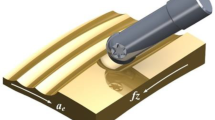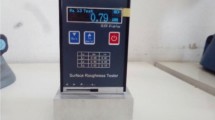Abstract
The surface quality of bearing rollers has great influence on the service performance of bearings. Electrochemical mechanical polishing (ECMP) is used to polish bearing rollers because it does not suffer from the disadvantages inherent in traditional bearing roller machining. However, predicting surface quality and determining processing parameters are difficult to accomplish because ECMP results are influenced by many factors. To overcome these problems, we develop an ECMP prediction model on the basis of least squares support vector machines with radial basis function. An orthogonal experiment is conducted to assess the effect of polishing parameters on surface roughness. Experiment results and predicted values show that ECMP is suitable for the machining of bearing rollers, with noticeable improvement in surface qualification. The mean absolute percent error (e MAPE) between the predicted and experimental values of surface roughness is 5.4%, and the root mean square error (e RMSE) is 6.5%. In addition, the e MAPE between the predicted and experimental values of current density is 4.8%, with an e RMSE of 6.6%.
Similar content being viewed by others
References
Neagu-Ventzel S, Cioc S, Marinescu I (2006) A wear model and simulation of superfinishing process: analysis for the superfinishing of bearing rings. Wear 260(9–10):1061–1069. doi:10.1016/j.wear.2005.07.024
Khalid F, Al-Raheem K, Roy A, Ramachandran KP, Harrison DK, Steven G (2009) Rolling element bearing faults diagnosis based on autocorrelation of optimized: wavelet de-noising technique. Int J Adv Manuf Technol 40(3–4):393–402. doi:10.1007/s00170-007-1330-3
Krzeminski-Freda H, Warda B (1996) Correction of the roller generators in spherical roller bearings. Wear 192(1–2):29–39. doi:10.1016/0043-1648(95)06739-6
Wei Y, Qin Y, Balendra R, Jiang Q (2004) FE analysis of a novel roller form: a deep end-cavity roller for roller-type bearings. J Mater Process Technol 145(2):233–241. doi:10.1016/S0924-0136(03)00674-5
Olofsson U (1997) An experimental investigation of wear and fatigue life reduction of boundary lubricated spherical roller thrust bearings. Tribol Int 30(9):685–692. doi:10.1016/S0301-679X(97)00042-X
Selvaraj A, Marappan R (2011) Experimental analysis of factors influencing the cage slip in cylindrical roller bearing. Int J Adv Manuf Technol 53(5–8):635–644. doi:10.1007/s00170-010-2854-5
Seo YJ (2011) Electrochemical-mechanical polishing application: monitoring of electrochemical copper removal from current–voltage characteristics in HNO3 electrolyte. Microelectron Eng 88(1):46–52. doi:10.1016/j.mee.2010.08.019
Marinescu ID, Uhlmann E, Doi TK (2006) Handbook of lapping and polishing. CRC Press, Boca Raton
Purcar M, Dorochenko A, Bortels L, Deconinck J, Bossche BV (2008) Advanced CAD integrated approach for 3D electrochemical machining simulations. J Mater Process Technol 203(1–3):58–71. doi:10.1016/j.jmatprotec.2007.09.082
Kozak J, Chuchro M, Ruszaj A, Karbowski K (2000) The computer aided simulation of electrochemical process with universal spherical electrodes when machining sculptured surfaces. J Mater Process Technol 107(1–3):283–287. doi:10.1016/S0924-0136(00)00697-X
Riggs JB, Muller RH, Tobias CW (1981) Prediction of work piece geometry in electrochemical cavity sinking. Electrochim Acta 26(8):961–969. doi:10.1016/0013-4686(81)85064-5
Desilva AKM, Pajak PT, Harrison DK, Mcgeough JA (2004) Modelling and experimental investigation of laser assisted jet electrochemical machining. CIRP Ann Manuf Technol 53(1):179–182. doi:10.1016/S0007-8506(07)60673-8
Zhang H, Xu J (2010) Modeling and experimental investigation of laser drilling with jet electrochemical machining. Chin J Aeronaut 23(4):454–460. doi:10.1016/S1000-9361(09)60241-7
Parthiban T, Ravi R, Kalaiselvi N (2007) Exploration of artificial neural network [ANN] to predict the electrochemical characteristics of lithium-ion cells. Electrochim Acta 53(4):1877–1882. doi:10.1016/j.electacta.2007.08.049
Pang GB, Xu WJ, Zhai XB, Zhou JJ (2004) Forecast and control of anode shape in electrochemical machining using neural network. Lect Notes Comput Sci 3174:262–268. doi:10.1007/978-3-540-28648-6_41
Vapnik VN (2000) The nature of statistical learning theory. Springer, New York
Suykens JAK, Vandewalle J (1999) Least squares support vector machine classifiers. Neural Process Lett 9(3):293. doi:10.1023/A:1018628609742
Suykens JAK, Gestel TV, Brabanter JD, Moor BD, Vandewalle J (2002) Least squares support vector machines. World Scientific Publishing, River Edge, New Jersey
Vong CM, Wong PK, Li YP (2006) Prediction of automotive engine power and torque using least squares support vector machines and Bayesian inference. Eng Appl Artif Intell 19(3):277–287. doi:10.1016/j.engappai.2005.09.001
Wei CH, Pai PF (2006) Predicting engine reliability by support vector machines. Int J Adv Manuf Technol 28(1–2):154–161. doi:10.1007/s00170-004-2340-z
Gencoglu MT, Uyar M (2009) Prediction of flashover voltage of insulators using least squares support vector machines. Expert Syst Appl 36(7):10789–10798. doi:10.1016/j.eswa.2009.02.021
Guo ZW, Bai GC (2009) Application of least squares support vector machine for regression to reliability analysis. Chin J Aeronaut 22(2):160–166. doi:10.1016/S1000-9361(08)60082-5
Glotsos D, Kalatzis I, Spyridonos P, Kostopoulos S, Daskalakis A, Athanasiadis E, Ravazoula P, Nikiforidis G, Cavouras D (2008) Improving accuracy in astrocytomas grading by integrating a robust least squares mapping driven support vector machine classifier into a two level grade classification scheme. Comput Methods Prog Biomed 90(3):251–261. doi:10.1016/j.cmpb.2008.01.006
Ramesh R, Ravi Kumar K, Anil G (2009) Automated intelligent manufacturing system for surface finish control in CNC milling using support vector machines. Int J Adv Manuf Technol 42(11–12):1103–1117. doi:10.1007/s00170-008-1676-1
Li X, Cao GY, Zhu XJ (2006) Modeling and control of PEMFC based on least squares support vector machines. Energ Convers Manag 47(7–8):1032–1050. doi:10.1016/j.enconman.2005.04.002
Pyle D (1999) Data preparation for data mining. Academic, San Diego
Patil NS, Shelokar PS, Jayaraman VK, Kulkarni BD (2005) Regression models using pattern search assisted least square support vector machines. Chem Eng Res Des 83(8):1030–1037. doi:10.1205/cherd.03144
Author information
Authors and Affiliations
Corresponding author
Rights and permissions
About this article
Cite this article
Xu, W., Wei, Z., Sun, J. et al. Surface quality prediction and processing parameter determination in electrochemical mechanical polishing of bearing rollers. Int J Adv Manuf Technol 63, 129–136 (2012). https://doi.org/10.1007/s00170-011-3891-4
Received:
Accepted:
Published:
Issue Date:
DOI: https://doi.org/10.1007/s00170-011-3891-4




